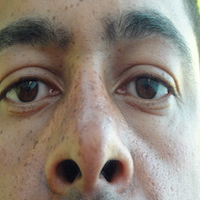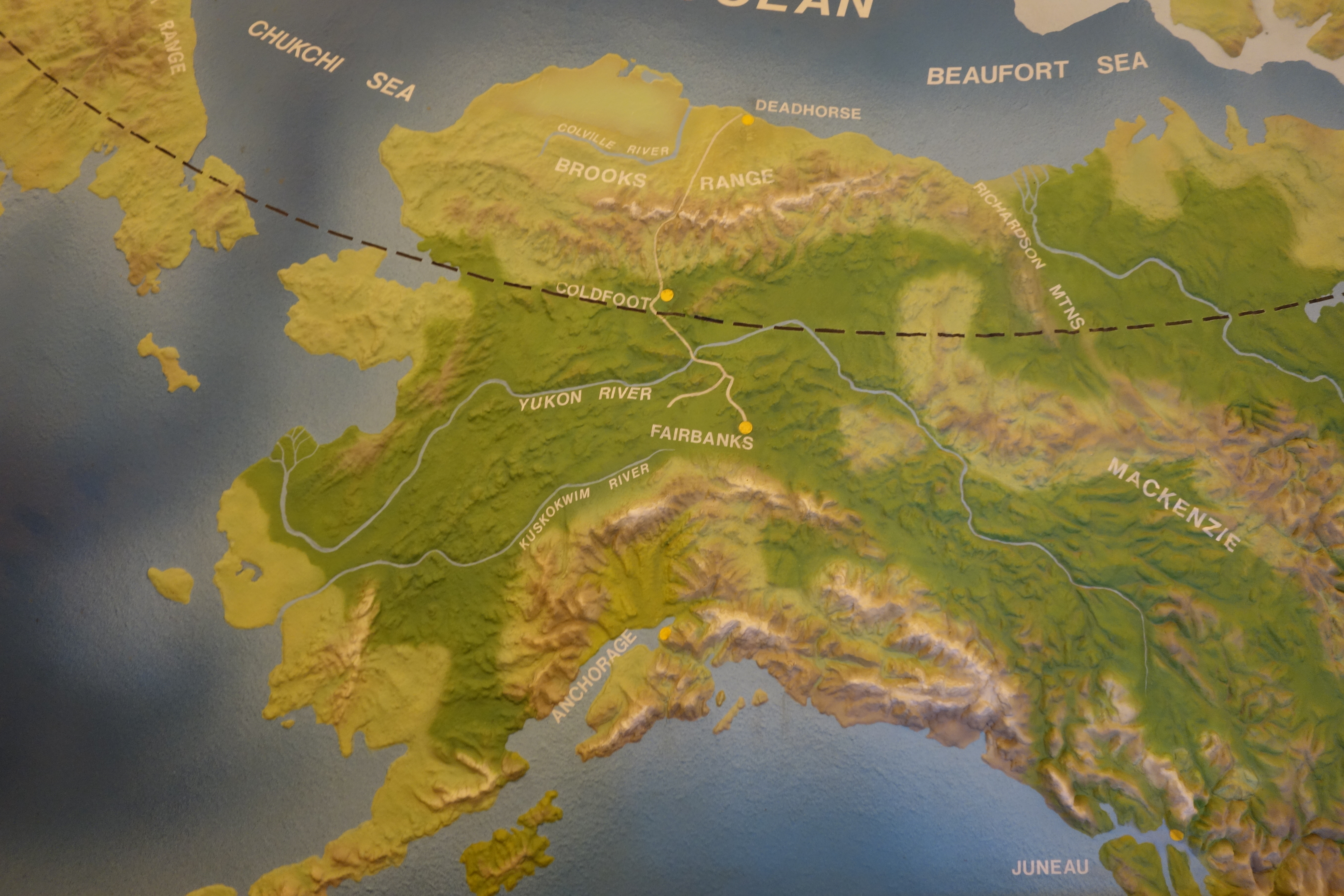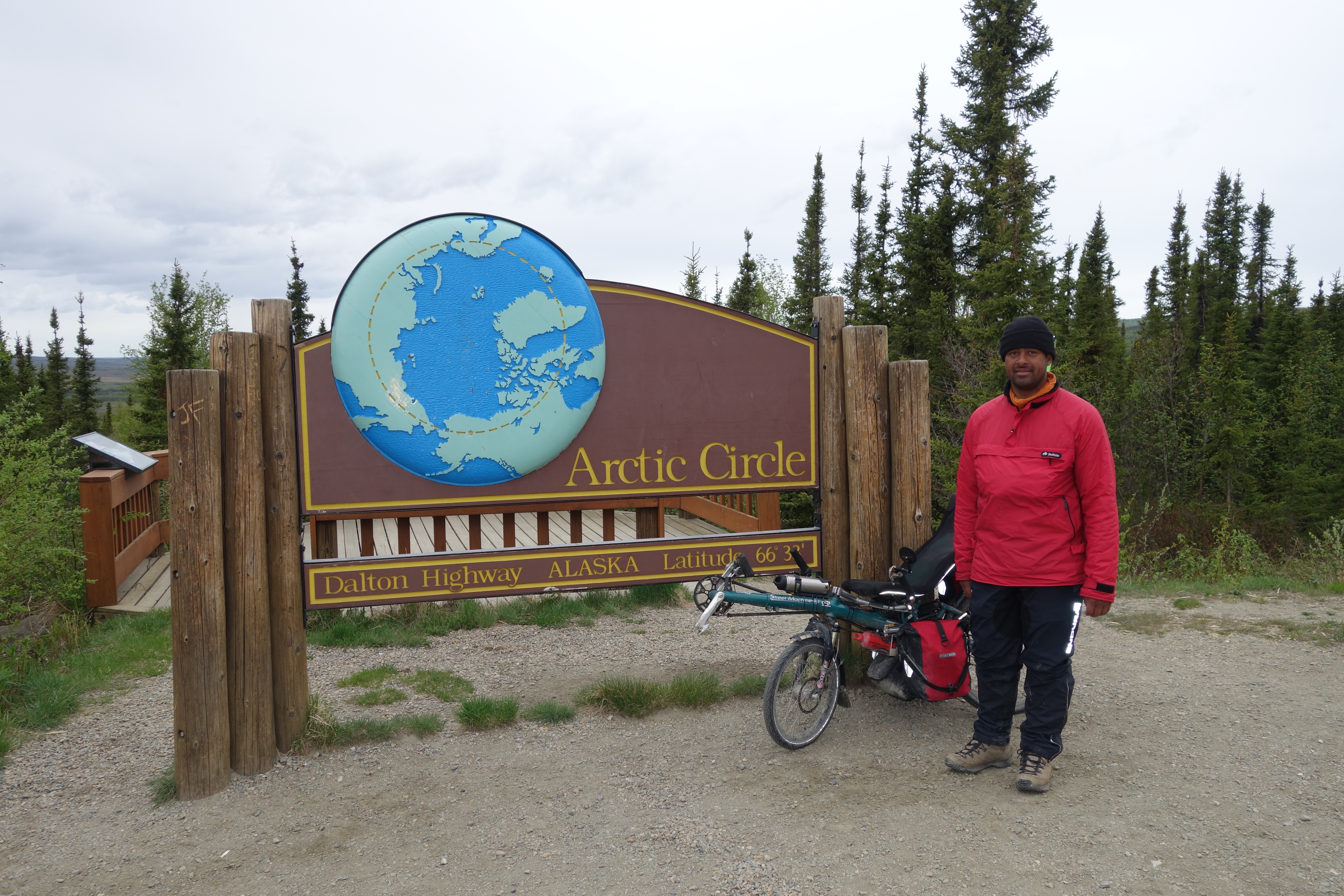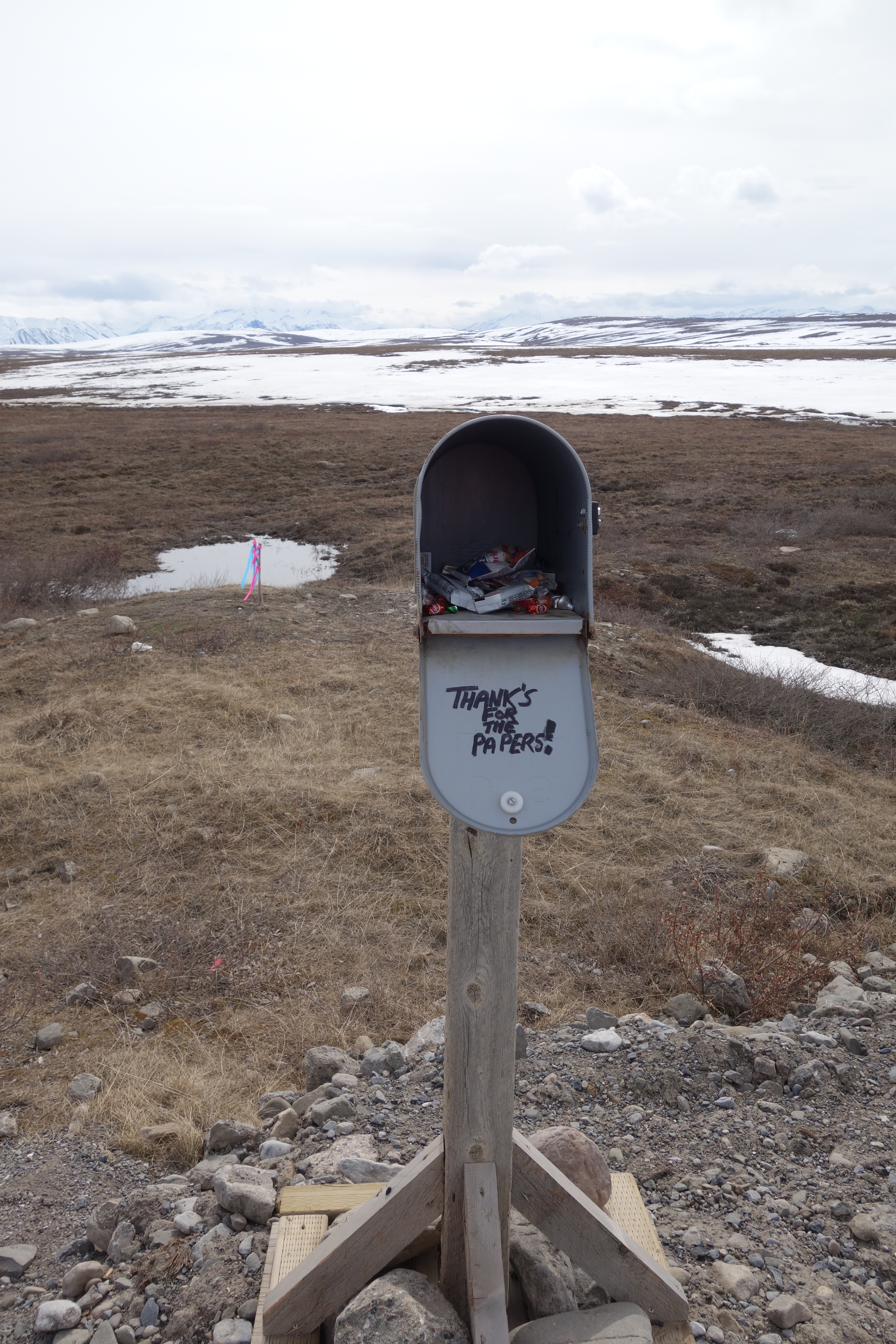0019: How to (really) survive the Dalton
I only rode half the Dalton highway and I certainly do not claim to be an expert on it now. But these notes collated from personal experience and other peoples information helped me and may help cyclists travelling along the same route.
How to get there
I flew up with Alaska Airlines. $75 for the bike and first 2 check bags for free IF you are flying entirely inside Alaska state.
There are shuttle services that run from Fairbanks but they are not cheap.
The cost of the shuttle service and the plane was similar and I personally didnt want the knowledge of what to expect as I was cycling back.
You could hitch a lift too, but the journey would still be difficult.
Also the thought of a 16 hour bus journey or 2 hours on the plane was more appealing.
Deadhorse
Is a work camp and industrial complex. It is a storage yard and lodgings for the workers on the oil fields. The only reason to visit is to say you started/finished there. Otherwise there are a couple of $200 a night hotels, an expensive general store, and the airport.
You cannot camp in the complex. If the trucks don't get you, the bears will!
When to go
I started on 26th May 2014. It was still very cold (-5C? and colder) and snowy on the north slope. The weather changes fast, so you need to go prepared for all eventualities. I'm told the first or second week in June is the ideal time to start.
North to south?
As you wish. For me, the thought of returning to 'civilisation' was more appealing. My personal route was the Pan American highway and that starts at the top in Deadhorse. If, like me you dont know what to expect then head for the place most likely to have a warm bed and a decent meal. You have food and rest options in Coldfoot and food only at Yukon bridge. That's all.
The road
is wet, muddy, dry, dusty, gravel topped, tarmac'ed, potholed, freshly paved, steep, flat and busy with trucks, and always changing. It's a real challenge on body and bike. They regularly spray the top surface with water and chemicals to hold it together and these can corrode your bike. Don't breathe in the dust and clean and oil your chain regularly. The hills are steep and you will likely hit a pothole or gravel patch at 40 mph on a descent. It is narrow in places so stick to your lane, especially on the brow of hills as truck will drift over to the other side. Be careful. The northern section is flat getting progressively hillier the closer you get to the Brooks range.
Atigun pass is steep and narrow and muddy.
The southern side, from the pass is hillier getting steeper, the closer you get to the start of the Dalton. At the time of writing there was a lot of construction work on the first 60 miles or so of the Dalton, heading up to the Arctic circle, so expect a LOT of mud/dust traffic depending on the weather. The hills around Livengood are also twisty and steep and I was advised by a truck driver to be careful here as the truck drivers often have difficulty seeing other cars, let alone cyclists.
Water
Take plenty and drink plenty.
The north slope is technically a desert. There are small streams but all water must be filtered, if it is not frozen. It is easy to become dehydrated even in cold conditions so keep sipping, even if you think you dont need it. The southern part has plenty of larger rivers. Just watch out for bears wandering along the banks.
Food Pack enough for the journey. Make sure it is in a Bear proof container and stash it away from your tent every night. Preferably downwind too.
Also put in anything else that smells strongly. Toiletries, perfumes etc. As these will also attract the animals to your location. As it happens, I didnt see any, but there were plenty of signs. Even if you don't see the big ones, the small ones can do damage by eating through your bags if they smell anything attractive. If necessary, you can forward an additional food parcel to the post office at Coldfoot. Bring all your litter home. Dont burn or bury it.
Weather
The north slope can quite easily see snow in July.
Be prepared at all times for the cold, wet and wind.
Take cold weather clothing and spares in case these become wet. You can easily post them home again from the post office at Coldfoot as the weather is milder on the south side of Atigun pass.
Animals
I didnt see any Bears, Wolves or anything else that might cause me problems, but it doesnt mean they aren't out there. I saw enough signs to know that it it is still wise to take precautions. The general store in Prudhoe bay does stock Bear spray, but to be sure, reserve it in advance as I'm told it often sells out.
As to its effectiveness? I hope I never have to find out.
I'm told generally a bear does not want anything to do wth humans. So if you make a lot of noise (bells, whistle, singing, talking) 99% of the time, all you will see is a furry bear behind running into the bushes. A wolf will smell you and be a mile away before you know it was even close. Is it that hunted animals are weary of humans? The problems come with those occasional curious animals, those with cubs or those that get surprised when they do see you.
I did see Musk Oxen in the distance and I understand they can be aggressive if you get too close. Again, Caribou will likely run away but will defend if they are calving. Foxes, Lynx, ground squirrels are all present and then there are hundreds of thousands of birds migrating to feed and breed. Ducks, Geese crows and other water birds.
Mosquitos and black fly are not generally a problem if the weather is cold, but come out fast in the warm weather! PROTECTION IS ESSENTIAL! Nets and repellents are an absolute must as these are Alaskan mozzies and like everything in Alaska they are HUGE! If you listen closely, I swear you can hear the 'tap tapping' as they try to puncture your Goretex jacket!
Trucks
The trucks come past fairly frequently 24 hours a day. They move fast and have right of way. They often appear without warning, though on some stretches of road it is possible to hear them from a long distance away. Keep to the right especially on hills or blind corners. The drivers are generally very respectful of cyclists and will usually slow down as they pass if they see you. Make sure you are very visible. I had reflective clothing, lights and a flag on my bike. Especially as the weather visibility can change fast. The trucks kick up a lot of dust and or mud as they pass, so use a mask to screen it. Also small stones and gravel so eye protection is essential.
Emergencies
Be very prepared. There are no emergency services the entire 496 miles from Deadhorse to Fairbanks.
There are no phones or phone reception except in Coldfoot where there is (expensive and slow) satellite internet. No police services or Ambulance. Having said that, there are several pump stations research stations and depots that may help you if it is a genuine life threatening emergency. That is, IF they are manned! These clearly advertise 'Private property' and 'no services' so it has to be a last resort. Also you could wave down a truck (or better a tourist, in the summer) as it passes and they may be able to contact someone? But as a general rule, you are on your own.
Camping
Unless it clearly states otherwise, you can camp pretty much anywhere. The North slope is very marshy in the spring time and the ground very waterlogged. There are a few gravel turn offs by the road side and I camped on these. You are very exposed to the wind and weather though. Make sure your tent and equipment is up to the job.
On the south side of the pass there is a lot more forest so you could hide in the trees. Make sure to stash your food though and make a lot of noise to deter the animals. Don't get too close to the road either as the dust will get you and noisy trucks don't make for a good night's sleep. There is an official campsite at Galbraithe lake but I'm told it isn't worth the 4 mile detour to get to. Another option is Marion creek campground about 4 miles north of Coldfoot.
Atigun pass
I was advised not to ride the pass in springtime as it was avalanche season. The year before a truck was pushed off the side of the pass. Fortunately the driver was not in the cab at the time. There are radio warnings at the top and the bottom, a cyclist would have no chance. I was offered a lift to the top and took it. And I am glad I did. The pass is not big compared to some I have seen and ridden, but it is narrow, steep and the weather closes in fast.
The road is narrow and muddy and you will likely pass several crazy truck drivers sliding down, trying to keep to their schedule. Ride in bad weather with great care!
It is rideable in the summer or dry weather but if there is any snow on the steep hill sides, I would play safe and drive over if possible. In bad weather there is nowhere to camp up. Chandalars shelf in the middle section is flatter but muddy. I would advise starting the bottom of the pass one morning and ride over in one go. Don't try to do it mid ride or at the end of the day. Camp up, food, water, sleep and start fresh the next day.
Coldfoot is your little island paradise in the vast tundra ocean. Stop here. Rest. Eat the real food (at surprisingly modest prices) have an expensive shower and/or sleep in a very expensive real bed.
There is no charge for camping up on the lawn. The visitor centre across the road is an interesting place to visit. And have a chat to the truck drivers at the restaurant about the road ahead. They have probably been chatting about you " Crazy cyclists!" on their radios for the past few days anyway!
Rest areas are non existent on the north slope but appear with more frequency on the south side. They often have Dry toilets which really look quite disgusting, but surprisingly don't smell.
There are often bear proof litter bins too. I used one to store my food overnight.
Arctic circle 66º 33' north. The point where the sun stops doing funny things in the sky and finally begins to set properly. Its a tourist area, so lots of toilets, picnic tables, car parking, graffiti and possible bears looking for a free meal. But the obligatory photos are a must. There is even a certificate you can write yourself. However this is only available from the visitor centre at Coldfoot 50 miles up the road!
People As a general rule, unless riding with someone you better get used to your own company - or like their company!
Most people along the Dalton are there to do a job.
There will be tourists, other cyclists and Motorbike riders, but mainly truckers, maintenance or security crews driving massive 4x4 pickup trucks. And they don't stop without good reason.
It can get a little lonely at times and my mind started playing tricks on me. But I would not advise riding with headphones as the trucks can appear quickly and on occasion very quietly despite their size. You will likely meet some interesting people along the route though and all are worth stopping and chatting to for a few minutes.
Scenery
Alaska is VAST. Riding the Dalton is a real challenge but also a feast for the eyes. You'll see some amazing things as well as face some real tests.
The mountains are big and steep, the roads are long and rough, the rivers are deep and wide and the weather is harsh and relentless.
Still, I would highly recommend riding the road.
Nevertheless, you will only have experienced a tiny percentage of what Alaska has to offer.
You have to be prepared as Alaska takes no prisoners.
Little miracles Be thankful for them. And know your limits. People will help. They will give advice and it is likely to be sound. Do your research. Contact and check with the locals. Don't be ashamed to accept a lift. But ultimately, enjoy the ride.
Oh, and check the mailbox at the Toolik lake junction.



